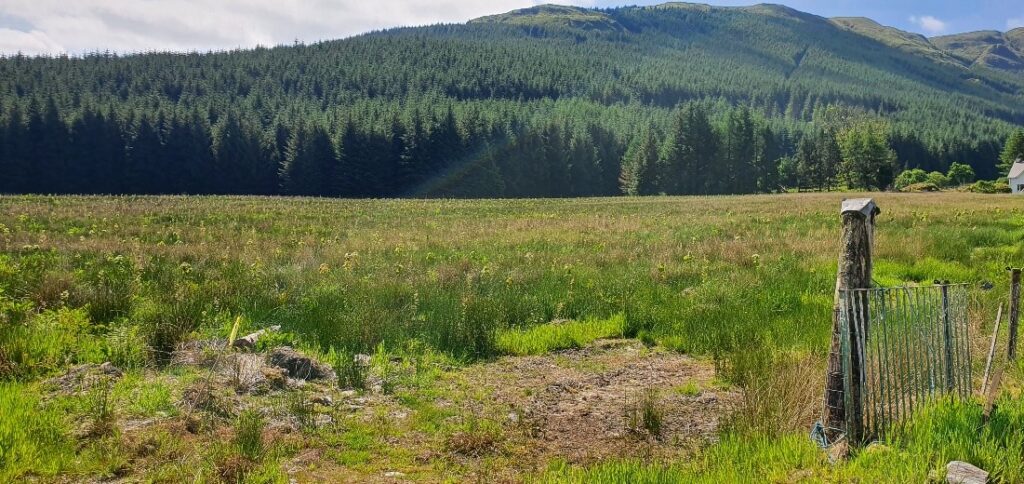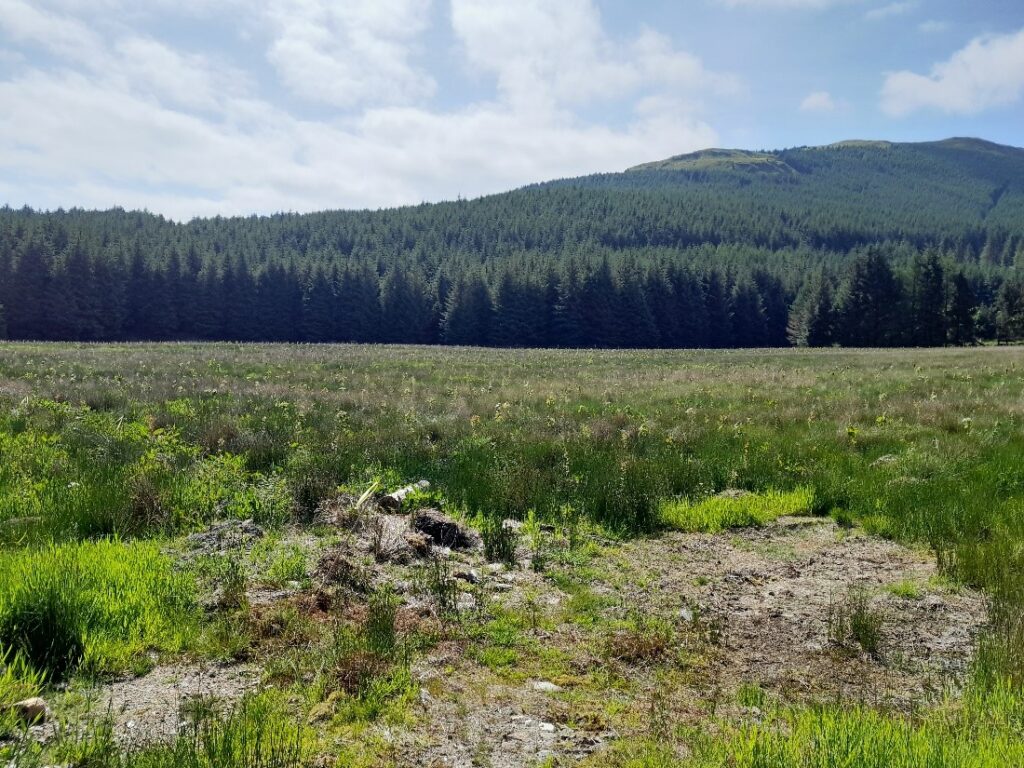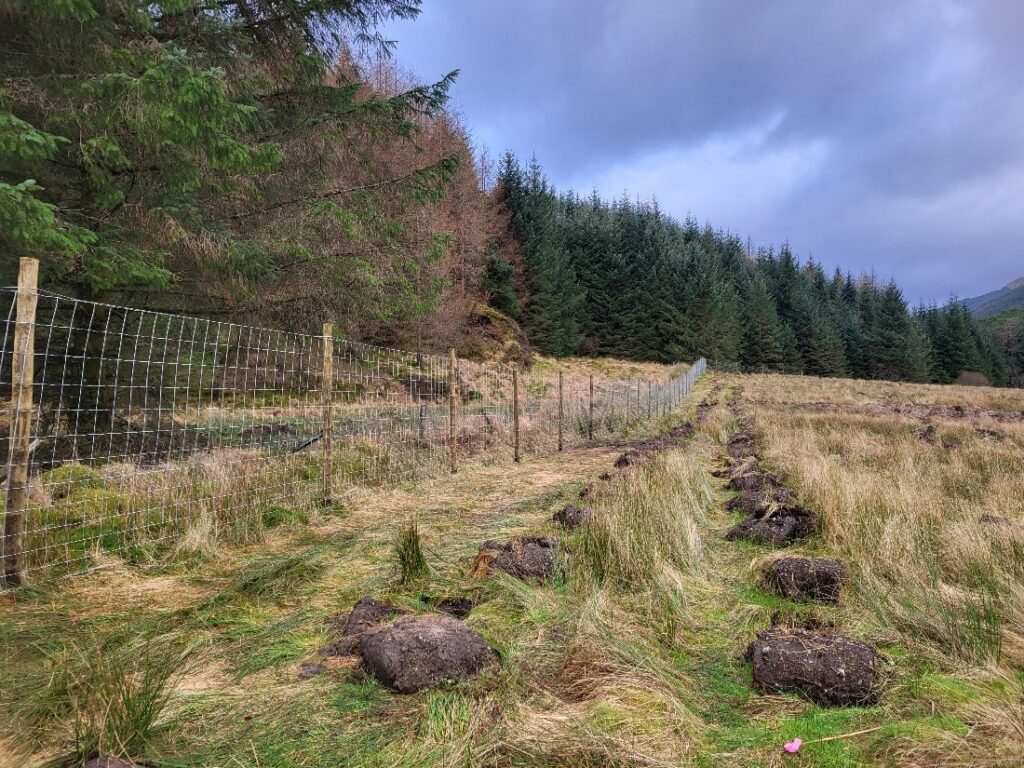Woodland Creation and Expansion for Carbon Sequestration and Habitat Improvement
Tilhill Forestry and CarbonStore, working closely with the farmer, designed and implemented the woodland creation plan at Accurrach.
Read more
Area: 17.17 hectares
Location: Argyll
Forest Manager: Tilhill Forestry
Carbon Project Developer: CarbonStore
Objectives: Improving native woodlands, public access diverse income streams
Trees Planted: 20,600
Year Planted: 2023
Carbon to be Sequestered: 5,953 tonnes
Working closely with the landowner, Tilhill Forestry designed and planted a woodland on land formerly used for grazing livestock. Having secured funding through the Forestry Grant Scheme, this project contributes towards government targets to mitigate climate change via carbon sequestration, through the expansion of woodland areas.
Corrachaive Farm, near Dunoon, covers a total area of 17.17 hectares. It consists of an area of mature mixed conifers, several small areas of isolated riparian native woodland, including native birch regeneration bordering the watercourses that run through the property.
Tilhill planted a mosaic of different trees species across 9.5 hectares of the land in order to connect the existing woodland habitats on the site, offer public access to a native woodland in the future and generate a small amount of firewood income. The remainder of the area is made up of watercourses, utilities, tracks, a hard-standing area, and the client’s residential property with its associated outbuildings.
The client made the decision to plant trees on the land, rather than farm it. He was keen to improve the landscape and visual amenity across the property and the wildlife and ecology of the area.
The client worked with Tilhill’s woodland carbon division, CarbonStore, to register and validate the woodland under the Woodland Carbon Code. As a leading expert on the Code, CarbonStore was able to advise the client on the likely costs and income associated with woodland carbon funding when the client comes to sell the woodland’s carbon credits.

The consultation with stakeholders, including the Community Council, took place in 2021 there being widespread support for the woodland creation proposals.
The proposals were also fully supported by NatureScot, Scotland’s nature agency, given the benefits to the landscape and the efforts made to improve native woodland habitat. Argyll and Bute Council also supported the sensitive expansion of the native woodland which they believed would enhance the area’s already-high scenic value.
Overall, the creation of new woodland at Corrachaive Farm will contribute to the woodland expansion targets in the UK, in accordance with the aspirations of the Argyll and Bute Council Forestry Strategy and Scottish Government’s Forestry Strategy.
During the project’s design phase, detailed surveys of the soil types, vegetation and peat depths were undertaken to inform the suitability of tree species and understand the potential planting areas.
Tilhill used ground preparation techniques that minimised ground disturbance and reduced soil compaction. Excavator hinge mounding – a low impact ground preparation technique – was used, as this helps reduce weed competition and encourages tree establishment.
Drainage was installed following planning and marking by the forest manager before starting operational works. All operations followed the Forest and Water Guidelines and adhered to current best practice.
An area of open ground was identified as deep peat and therefore mapped and excluded from the potential plantable area.

20,600 trees were planted across 9.5 hectares, consisting of a diverse mix of species. This included 6.32 hectares of productive broadleaf species such as Aspen, Silver Birch and Sycamore, as species suitable for future timber or firewood production. Additional native broadleaf species were planted across 4.43 hectares, consisting of more Aspen (2% of overall scheme), Silver Birch, Alder, Goat Willow, Wild Cherry and Scots Pine. All trees were sourced from the nearest available seed zones.
Scots pine was included within the native broadleaf component of the scheme at around 3% of planting, due to there being a mature stand of Scots pine currently on the property. Incorporating the new planting of Scots pine within the scheme will benefit the overall ecological diversity of the new woodland creation, both in terms of silvicultural diversity and by providing additional habitat benefits for species such as red squirrel.
All the trees were hand-planted bare-root into the mounds created during ground preparation operations.
Deer fencing was installed in three distinct enclosures to exclude deer from the site and protect the young saplings. The enclosures were created due to the impracticality of one single fence because of the water constraints on site. This avoided having to install water gates which can produce weak points following heavy rainfall and hinder public access.
The decision was taken to avoid plastic tree shelter tubes on the site for ease of management and to avoid plastics in the forest.

The project aims to enhance the conservation value of the local area by increasing native woodland habitat connectivity. The new woodland planting creates habitat corridors between existing isolated native woodland areas to the east, west and north of the site.
As the trees grow, they will provide links with existing native woodland which will also deliver landscape benefits and provide improved habitat for key wildlife species such as bats, otters, and red squirrels. Tilhill forest managers will continue to work closely with the local Raptor Study Group to monitor owl activity and provide suggestions to enhance their habitat on site including provision of nest boxes.
A survey completed by the Tilhill Ecologist also identified an area of wet, species-rich grassland which was excluded from the planting design. Areas of open ground were also left for diversity and for certain wildlife species which thrive in open land.

Water quality and flood resilience were also important factors to consider alongside habitat creation and landscape enhancement. The Scottish Environment Protection Agency (SEPA) assessed the woodland creation plans against the Forestry and Water Guidelines to ensure the protection of water courses. As the trees grow, they will eventually mitigate flood risk and improve water quality.
Pedestrian gates were installed to ensure and encourage public pedestrian access to the woodlands.
The forest is being managed in accordance with the Government’s UK Forestry Standard (UKFS), the reference standard for sustainable forest management. This ensures the application of sustainable management, climate change considerations and the protection of biodiversity and water resources, all verified through the UK Woodland Assurance Standard.
Regular site visits have been factored into the management plan to monitor plant health and establishment. Hand-weeding will be done annually where applicable until the trees are established. Management also includes monitoring for mortality rates of the trees, which will inform annual beat-up operations to maintain appropriate stocking densities until an appropriately stocked woodland is established.
Ongoing wildlife management, in the form of deer management, is being undertaken on the site to prevent deer entering the fenced areas and to sustainably control the population. The site is part of a deer stalking syndicate and there is a local larder nearby for the storage of the venison produced in the area to enter the local food supply.
CarbonStore, Tilhill’s woodland carbon division, worked with the landowner and the forest manager to complete all the necessary documentation for registration and validation of the project by the Woodland Carbon Code.
As the landowner lives on site, the future carbon income will be spent in the local area, and on upkeep of the property and the farmhouse. Without carbon funding, the project was not considered financially viable.
It is estimated that the woodland will capture 5,953 tonnes of carbon over the next 100 years, according to the Woodland Carbon Code. The units can be sold to a third party who has already reduced their carbon footprint as much as possible and is seeking to offset their residual carbon emissions.
CarbonStore will also continue to arrange ongoing site verifications to certify that carbon sequestration is occurring and calculate the volume of carbon capture.
The wide-ranging advantages of trees mean that woodland creation can serve as a completely natural solution to numerous environmental challenges. From connecting existing woodlands to improve habitat to creating better public access, this project will yield long-term benefits for the surrounding community. Moreover, the income generated from the timber will go back into the local economy, and the carbon offset will contribute to the broader objective of achieving net-zero in the UK.
In partnership with Tilhill Forestry, CarbonStore can help you deliver new woodland creation and woodland-based carbon mitigation projects that not only achieves the highest possible standards in carbon offsetting but also offers many widespread benefits which we can all enjoy.
Please contact David McCulloch, the head of CarbonStore, personally either by email (david.mcculloch@carbonstoreuk.com) or by phone (07500 950832).